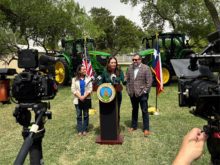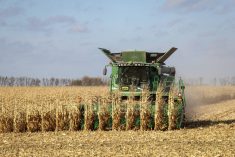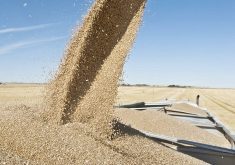CAP is a rather fitting acronym for the recently announced Canadian Agricultural Partnership, the latest government ‘policy framework’ that governs its farm support programs.
“That’s a very easy way for people to remember the two major changes that have come about here,” said Steve Funk, director of farm income programs at MNP.
“They’ve capped the AgriInvest benefits at $10,000 instead of $15,000, and they’re putting a cap on the AgriStability reference margin limiting.”
The policy framework covers a host of programs — from farm support and research to climate change and “public trust” — that will collectively receive $3 billion in federal and provincial funding over the next five years (beginning in April). Alberta will have some individualized versions, but the key item for most producers will be Ottawa’s business risk management programs — AgriStability, AgriInvest, and AgriInsurance.
AgriStability is the big one in that trio, and both farm groups and governments have been worried about declining participation levels. Ottawa has agreed to review the program and it will be interesting to see if that changes anything, said Funk.
“Who knows what will come down the pipe?” he said. “They’ve agreed to the review, so whatever comes out of that, I think they’d be remiss not to take into account people’s opinions going through that review.”

AgriStability mechanics
But one important change has already been made based on producer feedback — capping the reference margin limit in the AgriStability program.
“They had to do something about the reference margin limiting under AgriStability, and I think that they accomplished that,” said Funk.
“They have put a limit on the limited reference margin, and the limit is at least 70 per cent of the conventional reference margin. It could be greater if that’s where the calculations cause the producer to fall, but it will never be less than 70 per cent of the conventional reference margin.”
Under Growing Forward 2, the AgriStability program calculated reference margins — allowable income minus allowable expenses — based on the ‘Olympic average’ of the previous five years’ margins (meaning the highest and lowest margin years were dropped). In 2013, the program introduced a reference margin limit, and with that change, the payment calculation was then based on the lower of the Olympic average or the average allowable expenses in the same three-year period.
Read Also

Farming Smarter receives financial boost from Alberta government for potato research
Farming Smarter near Lethbridge got a boost to its research equipment, thanks to the Alberta government’s increase in funding for research associations.
That change “particularly impacted” producers with a low cost structure, said Funk.
“Anybody who has a low cost structure would be potentially limited,” he said. “Some were limited to such a great extent that it didn’t make sense for them to participate in the program anymore.”
Those declining participation rates may have driven changes to the program under the new Canadian Agricultural Partnership agreement.
“I think that participation rates were a concern across the board for governments,” said Funk. “On one hand, they have a budget concern, but on the other, they don’t like it when they see producers dropping out of a program that could protect them in the event of a shortfall.
“This is a big move toward bolstering participation rates.”
Late participation
The agreement also includes a mechanism to allow for late participation in AgriStability.
“It appears that this provision is going to work on more of an area or sector basis, rather than on an individual farm basis, but we don’t have a lot of details,” said Funk.
The mechanism could be triggered by provincial governments to allow producers to enter the program after the deadline in instances where there is a “significant income drop” as a result of “significant events.”
“For example, if there was a drought in such-and-such a region, the government in that province might declare that they’re going to open it up and anybody who didn’t sign up for AgriStability can now sign up,” said Funk.
“Or if something went wrong in the hog industry, multiple provinces might look at that and say, ‘We should open this up to the hog industry to sign up late.’”
Not all provinces are on board with that change, however.
Saskatchewan Agriculture Minister Lyle Stewart said it would negatively affect enrolment in AgriStability, as producers would have little incentive to use the program to manage their risk proactively. (Late enrolments would be subject to a 20 per cent loss in benefits.)
“Late participation will not be available for Saskatchewan producers, and I believe a number of other provinces are going to take the same tack with that,” said Stewart.
AgriInvest changes
In order to pay for a more costly AgriStability, the government funnelled some funds from AgriInvest — reducing both the allowable net sales eligibility to $1 million (from $1.5 million currently) and annual government matching contributions to $10,000 (from $15,000 currently).
“That’s going to affect a large number of producers. It’s not very hard anymore to achieve a million dollars in allowable net sales,” said Funk.
Even so, participation rates in AgriInvest shouldn’t drop as a result of the change.
“AgriInvest is relatively easy to apply for and it’s 100 per cent matching,” said Funk.
“In some cases now, we’re going to have producers who would have qualified for between $10,000 and $15,000 in benefits. Now they’re limited to $10,000 instead of $15,000. So they’ll see their benefits go down, but I don’t think it’s any reason to drop the program.”
Robbing Peter to pay Paul makes sense in this case, he said.
“More money is always better, but given that they had decided they would have no budget increase, they were probably able to accomplish some significant things here just by capping the term limit on AgriStability and using some AgriInvest funds as a primary means of doing that.
“I’m actually quite happy with what they came out with.”
Many other programs that fall under the Canadian Agricultural Partnership are more sector specific or target things like trade and research. The six priority areas are: science, research, and innovation; markets and trade; environmental sustainability and climate change; value-added agriculture and agri-food processing; public trust; and risk management. The agreement will come into effect April 1. A “bilateral agreement” detailing specific cost-shared programs for Alberta will be worked out over the next few months, said Alberta Agriculture Minister Oneil Carlier.















